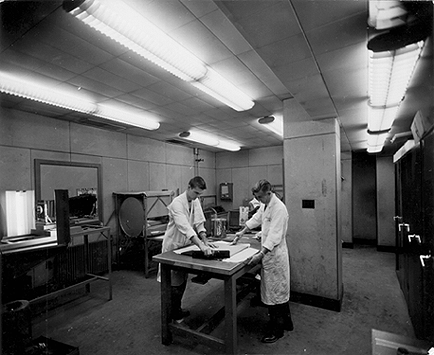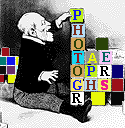

The Pittsburgh Photographic Library (PPL) is a repository consisting of numerous photographic collections that have been acquired by The Carnegie Library of Pittsburgh since 1960. The collections are housed in the Pennsylvania Department at the main Carnegie Library in Oakland. When it opened in the summer of 1960, the PPL contained three collections, and these continue to form the nucleus of photographs and other graphic illustrations which document over 200 years of Pittsburgh history. The original collections include: 1,500 images used to illustrate the book, A Pittsburgh Album, written by photo documentalist Roy Stryker and published by the Pittsburgh Post-Gazette in honor of the city's 1958-1959 bicentennial anniversary; the Bingaman collection of over 1,000 photographs taken in the first quarter of the century by Frank E. Bingaman, photographer for the Pittsburgh Sun-Telegraph; and the Pittsburgh Photographic Library, a collection of roughly 18,000 photographs which were taken in the early 1950s as a documentation project, and which subsequently gave the repository its present name.
In anticipation of the opening in 1960, Dr. Ralph Munn, then director of the Carnegie Library, announced the new service would be "an aid to students, teachers, authors, researchers, advertisers and others in need of pictorial material about Pittsburgh." The photo library was established with funds contributed by the A.W. Mellon Educational and Charitable Trust, Howard Heinz Endowment, Hunt Foundation, and the Post-Gazette. Within a year after the opening, the City of Pittsburgh's Department of Public Works donated 100 of its photographs, many by Pittsburgh native, Brady W. Stewart. An agreement was made with photo journalist Stefan Lorant to donate the 1,000 documents he had amassed in preparation for his book, Pittsburgh: The Story of an American City. In addition, another Pittsburgh photographer, Abram M. Brown would soon contribute his priceless collection of glass plate negatives documenting local communities and the Pennsylvania Railroad at the turn of the century.
It was in June 1950 that Dr. R.H. Fitzgerald, then chancellor of the University of Pittsburgh, announced the establishment of a photographic library and the appointment of Roy Stryker as the director. Stryker had already achieved national acclaim directing photographers such as Dorothea Lange and Walker Evans in documenting the Great Depression for the Farm Security Administration project. While working for the Standard Oil Company of New Jersey in documenting their activities in the field, he was approached about coming to Pittsburgh to create a collection of photographs about the city and its people. In particular, the documentation would record the changes ("progress") that urban renewal was bringing to the steel city. Stryker was responsible for hiring professional photographers and for directing the project, which was to be based at the University of Pittsburgh.
In a letter anticipating his new venture, Stryker noted that, "No other city has ever attempted to make such a use of photography, and I think it significant that the camera -- itself an offspring of modern technology -- should be considered to have a real function in a great industrial center which is beginning to examine itself critically and carefully planning for the future." He saw one of the objectives of the project would be "To enable people in the rest of the country to see modern Pittsburgh as it really is, not only as the nation's workshop and the heart of heavy industry, but as a dynamic city with an implemented plan for the future."
The library and its laboratory facilities were located on the 30th floor of the Cathedral of Learning. Financed by gifts from the A.W. Mellon Educational and Charitable Trust, the Allegheny Conference on Community Development, and the Edgar Kaufmann Charitable Trust, the PPL would accomplish "the most complete photographic documentation ever achieved by any American community." The primary purpose of the PPL was "to develop a documentary collection of photographs on Pittsburgh and Western Pennsylvania in such a fashion as to record and preserve, visually, the life, customs, and activities of the people of this area with relation to their physical environment." Although the University of Pittsburgh chancellor envisioned the library being accessed primarily by students in studying matters of community development and industrial enterprise in the Pittsburgh area, it also proved to be a rich resource of images used by both advertisers and local industry.
Of primary importance was the documentation of Pittsburgh's current building "renaissance." The project's photographers were assigned to specific areas and events in order to capture the transition from old to new, and the social and cultural activities surrounding it. With Harold Corsini heading the technical department, photographers assigned to the project included James Blair, Esther Bubley, Arnold Eagle, Elliott Erwitt, Regina Fisher, Clyde Hare, Russell Lee, Sol Libsohn, Charles Nelson, Fran Nestler, and Richard Saunders. By the time Stryker left the project in 1952, his staff had produced well over 18,000 photographs covering aspects of community planning, education, health, welfare, industry, labor, and cultural activities. The project continued for several years under the direction of Marshall Stalley, and was phased out in the late 1950s.
For a while, it looked as though the library would be transferred to the Library of Congress. But then the Carnegie Library stepped in, citing its lack of an adequate file of local pictures and promising to "furnish adequate and safe space for the preservation and use of these files." The Pittsburgh Photographic Library was thus transferred to the main Carnegie Library in June 1960.
Today, after several decades of acquisition, there are an estimated 57,000 images that comprise the Carnegie's Pittsburgh Photographic Library. In addition to the collections already mentioned above, the PPL also houses a collection of photographs by Johnstown native, Luke Swank; illustrations by the cartoonist, Cy Hungerford; a collection of images relating to Andrew Carnegie; and a photographic history of local amusement parks, among others.
Selective examples from these collections are available to the public through copies which are filed according to subject category in cabinets located in the Pennsylvania Department. These images may be reproduced for a nominal charge. In addition, many of these photographs have been digitally scanned and can be viewed simply by clicking on the photographers' names. (Photos are still being scanned in.)
Enjoy!
Sources: Pittsburgh Photographic Library, Report on Purposes, Organization, and Operating Procedures, Revised and Approved, June 14, 1951, and letter from Roy Stryker to Wallace Richards (Carnegie Museum), dated November 7, 1949 -- from the Archives of Industrial Society at the University of Pittsburgh. "City 'Photo File' Planned," March 17, 1960, and "Carnegie Library Goes Pictorial," April 15, 1961, from The Pittsburgh Post-Gazette.
pd
